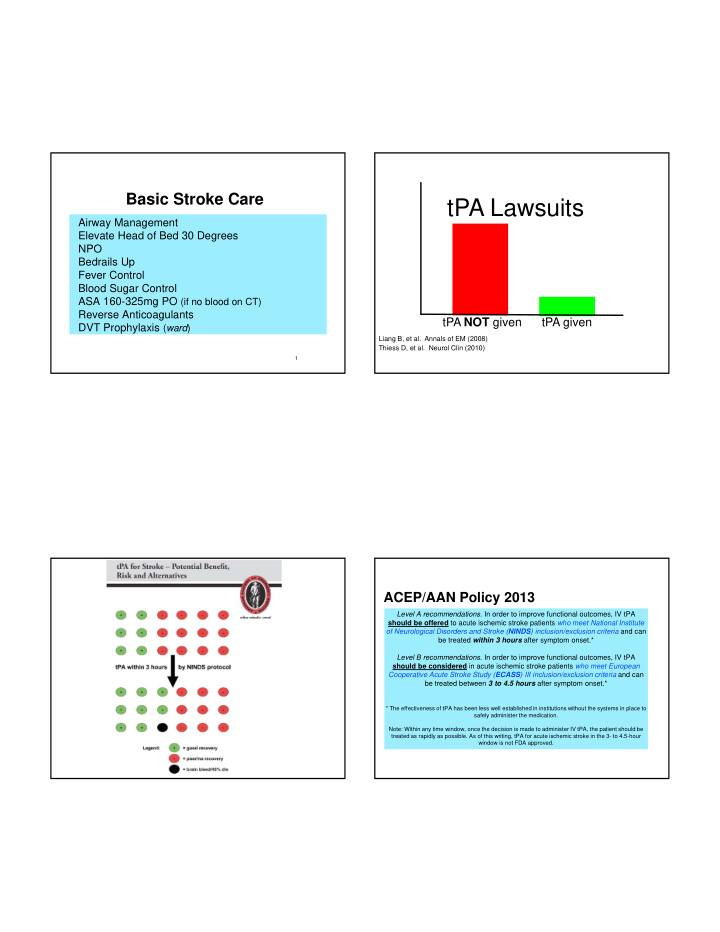



2/19/2014 Basic Stroke Care tPA Lawsuits Airway Management Elevate Head of Bed 30 Degrees NPO Bedrails Up Fever Control Blood Sugar Control ASA 160-325mg PO (if no blood on CT) Reverse Anticoagulants tPA NOT given tPA given DVT Prophylaxis ( ward ) Liang B, et al. Annals of EM (2008) Thiess D, et al. Neurol Clin (2010) 1 ACEP/AAN Policy 2013 Level A recommendations. In order to improve functional outcomes, IV tPA should be offered to acute ischemic stroke patients who meet National Institute of Neurological Disorders and Stroke ( NINDS ) inclusion/exclusion criteria and can be treated within 3 hours after symptom onset.* Level B recommendations. In order to improve functional outcomes, IV tPA should be considered in acute ischemic stroke patients who meet European Cooperative Acute Stroke Study ( ECASS ) III inclusion/exclusion criteria and can be treated between 3 to 4.5 hours after symptom onset.* * The effectiveness of tPA has been less well established in institutions without the systems in place to safely administer the medication. Note: Within any time window, once the decision is made to administer IV tPA, the patient should be treated as rapidly as possible. As of this writing, tPA for acute ischemic stroke in the 3- to 4.5-hour window is not FDA approved. 1
2/19/2014 Vertigo Dizziness Dizziness 2014 Not Missing Something BAD Stuart Swadron MD FRCPC FAAEM FACEP University of Southern California Los Angeles County/USC Medical Center 2
2/19/2014 Dizziness Dizziness Dizziness Dizziness Lightheadedness Lightheadedness Vertigo Vertigo Lightheadedness Lightheadedness Vertigo Vertigo Dysequilibrium Dysequilibrium Dysequilibrium Dysequilibrium Dizziness Dizziness Vertigo Vertigo Lightheadedness Lightheadedness Dysequilibrium Dysequilibrium 3
2/19/2014 6 6 Central Peripheral Central Peripheral 3 4 5 6 3 4 5 6 7 8 7 8 9 10 9 10 12 12 Cerebellum Cerebellum Tinnitis Hearing Loss The 5 D’s and Crossed Findings D izziness (vertigo) Walk D iploplia Long tract findings D ysarthria (motor/sensory) D ysphagia D ysmetria Any of these = CENTRAL = BAD 4
2/19/2014 5
2/19/2014 Vertigo 2014 1. Make sure that it’s isolated 31,000 patients Discharged with diagnosis of vertigo or dizziness Stroke in only 1 in 500 in the first month Isolated Vertigo ACUTE CEREBELLAR BPPV VESTIBULAR STROKE SYNDROME Et Viral Vascular Otolith debris Sx < 1 minute Gradual onset Sudden onset episodes Positive Positive Negative Dx Head Impulse Dix-Hallpike Head Impulse test test test Suppression Rx Epley Admission meds ASA maneuver Corticosteroids 6
2/19/2014 Delayed onset Fatiguable QuickTime™ and a decompressor are needed to see this picture. Decreases with fixation Nystagmus in Peripheral Vertigo Isolated Vertigo The Head Impulse Test ACUTE CEREBELLAR BPPV VESTIBULAR STROKE Negative SYNDROME Et Viral Vascular Otolith debris (normal) Sx < 1 minute Gradual onset Sudden onset episodes Positive Positive Negative Dx Head Impulse Dix-Hallpike Head Impulse test test test Positive Suppression Rx Epley Admission meds ASA maneuver Corticosteroids 7
2/19/2014 QuickTime™ and a QuickTime™ and a decompressor decompressor are needed to see this picture. are needed to see this picture. Negative (normal) Head Impulse Postive (R-sided) Head Impulse Test Test QuickTime™ and a QuickTime™ and a decompressor decompressor are needed to see this picture. are needed to see this picture. Postive (bilateral) Head Impulse CENTRAL!!! Test 8
2/19/2014 SKEW! SKEW! QuickTime™ and a decompressor are needed to see this picture. SKEW! Central Nystagmus HINTS QuickTime™ and a decompressor are needed to see this picture. Test of Skew Head Impulse 9
2/19/2014 Vertigo Isolated Vertigo 2014 ACUTE CEREBELLAR BPPV VESTIBULAR STROKE SYNDROME Et 1. Make sure that it’s isolated Viral Otolith debris Vascular 2. Consider: Sx < 1 minute Gradual onset Sudden onset episodes Acute Vestibular Neuritis Positive Positive Negative Dx BPPV Head Impulse Dix-Hallpike Head Impulse test test test Cerebellar stroke Suppression Epley Rx Admission meds ASA maneuver Corticosteroids Dizziness Dizziness Dizziness Dizziness Vertigo Vertigo Lightheadedness Lightheadedness Dysequilibrium Dysequilibrium 10
2/19/2014 Dizziness Dizziness Dizziness Dizziness Lightheadedness Lightheadedness Vertigo Vertigo Lightheadedness Lightheadedness Vertigo Vertigo Dysequilibrium Dysequilibrium Dysequilibrium Dysequilibrium 5D’s 5D’s Long Tract Signs Long Tract Signs YES YES Dizziness Dizziness CT scan CT scan Vertigo Vertigo Lightheadedness Lightheadedness Dysequilibrium Dysequilibrium NO NO Is it isolated? Is it isolated? 11
2/19/2014 5D’s 5D’s MRI / Admit MRI / Admit Long Tract Signs Long Tract Signs YES YES CT scan CT scan NO NO Vertigo 2014 A cute A cute C erebellar C erebellar B PV B PV Vestibular Vestibular Thank you! Stroke Stroke Brief episodes Neuritis Neuritis + Dix-Hallpike Gradual onset Abrupt onset + Head Impulse - Head Impulse swadron@usc.edu 12
Recommend
More recommend